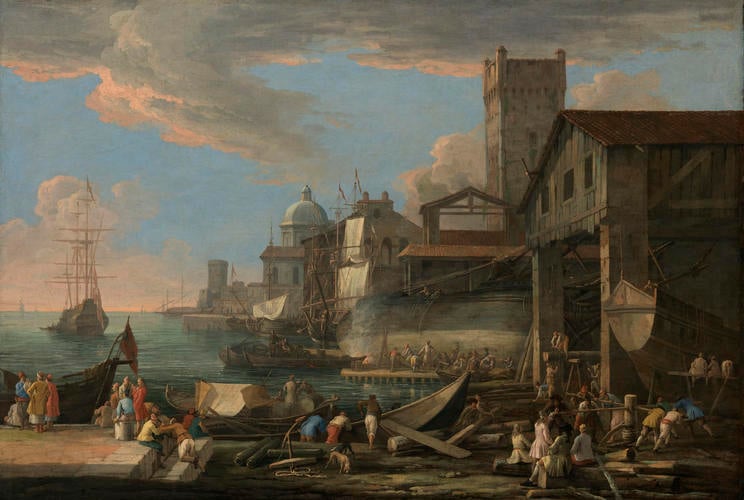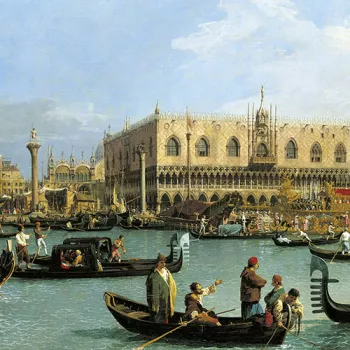A Capriccio View with a Shipyard c. 1710-14
Oil on canvas | 98.2 x 145.1 cm (support, canvas/panel/stretcher external) | RCIN 405315
-
Luca Carlevarijs was Canaletto's principal predecessor in the genre of Venetian view paintings. His greatest success was with the commemorative paintings recording the receptions and regattas given in honour of visiting dignitaries, and the great festivals and regattas of Venice. He also published an important series of etched views of Venice, Le Fabriche, e Vedute di Venezia (1703), which shared a better knowledge of the beauty and greatness of the city with a wider audience and proved to be a useful resource for all successive Venetian view painters.
This work, and A Caprice View of a Harbour (RCIN 405314), are among six by Carlevarijs in the 'Italian List', probably commissioned by Smith soon after his arrival in Venice. Each combines recognisable Roman and fictional elements in an imaginary setting to create an ideal view. Carlevarijs made a group of about 15 capricci with similar motifs, dated between about 1710 and 1714. He had just completed his great Regatta held for King Frederick IV of Denmark (Det Nationalhistoriske Museum på Frederiksborg, Hillerød), as well as The Bucintoro Departing from the Bacino di San Marco (J. Paul Getty Museum), and now turned back to painting fantasy landscapes for a more local market. Both of these paintings show seaports with antique and medieval elements animated by ordinary working figures, often fishermen or boatbuilders, and others working or travelling. The so-called bamboccianti, the mid-seventeenth-century Northern artists working in Rome, had popularised paintings of contemporary inhabitants of Rome. By this date Carlevarijs could draw on a rich tradition for his paintings in this genre.
The setting here recalls the Arsenale in Venice. Beyond it are towers, the nearer reminiscent of the fortified Roman Torre delle Milizie (Tower of the Militia) in Rome. The fire used to caulk the huge hull of a ship in the centre of the composition is an additional source of dramatic light. Such light effects had been pioneered by artists in Rome, such as the German Adam Elsheimer (1578–1610) and Paul Bril (c.1554–1626) from Antwerp, both skilled in the genre of imaginary landscapes.
Carlevarijs's training in perspective, and his recording of Venetian buildings for his etchings, meant that his architecture is accurately depicted and has a weighty grandeur, with magnificent Roman ruins standing in heroic isolation. His skies, though filled with dramatic clouds, are touched with rosy pink rather than being dark and stormy. The colours are bright and the light is clear, with the sea air growing gradually hazier in the distance. His imaginative landscapes are peopled with ordinary workers who root the scenes in the everyday. Yet the settings of ports and seashores with open sea beyond give his capricci an imaginative fantasy, suggesting the passage of time and the limitless possibilities of travel to other worlds.
By the 1720s Carlevarijs was relying on his successful formula but his patrons – and especially Joseph Smith – were turning to the younger and rising Canaletto.
Text adapted from Canaletto & the Art of Venice, 2017.
Provenance
Acquired in 1762 by George III from Joseph Smith, British Consul in Venice (Italian List nos 252-5); recorded in the Great Room of the Library at Buckingham Palace in 1790
-
Medium and techniques
Oil on canvas
Measurements
98.2 x 145.1 cm (support, canvas/panel/stretcher external)
127.0 x 172.4 x 10.0 cm (frame, external)










